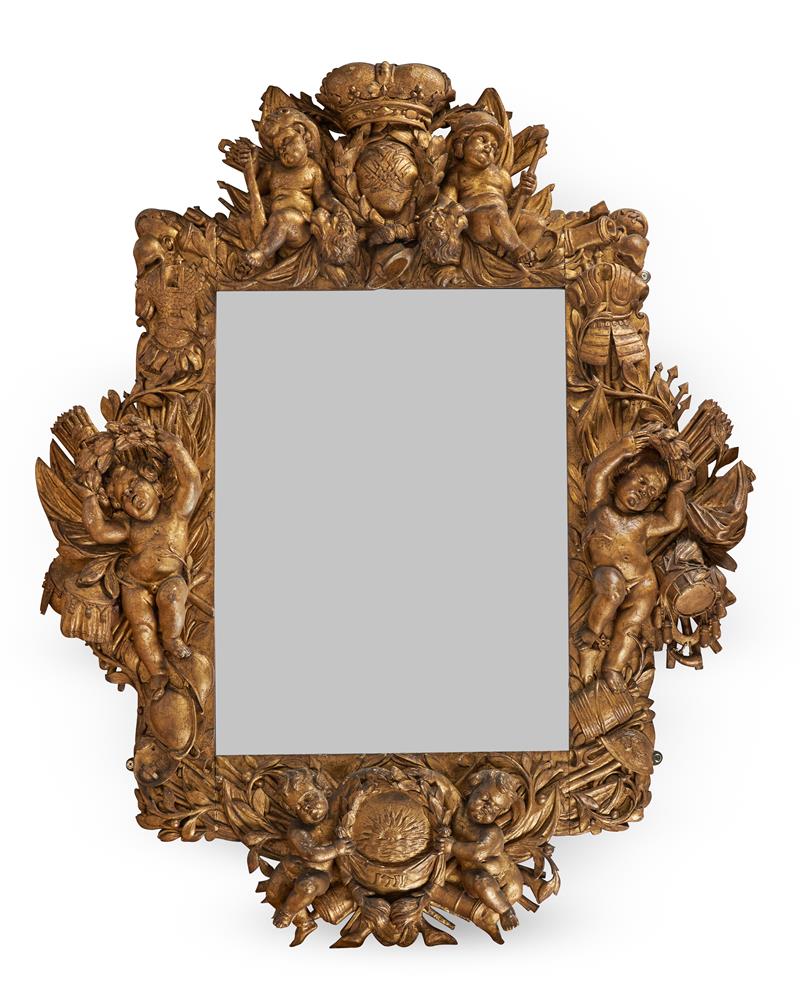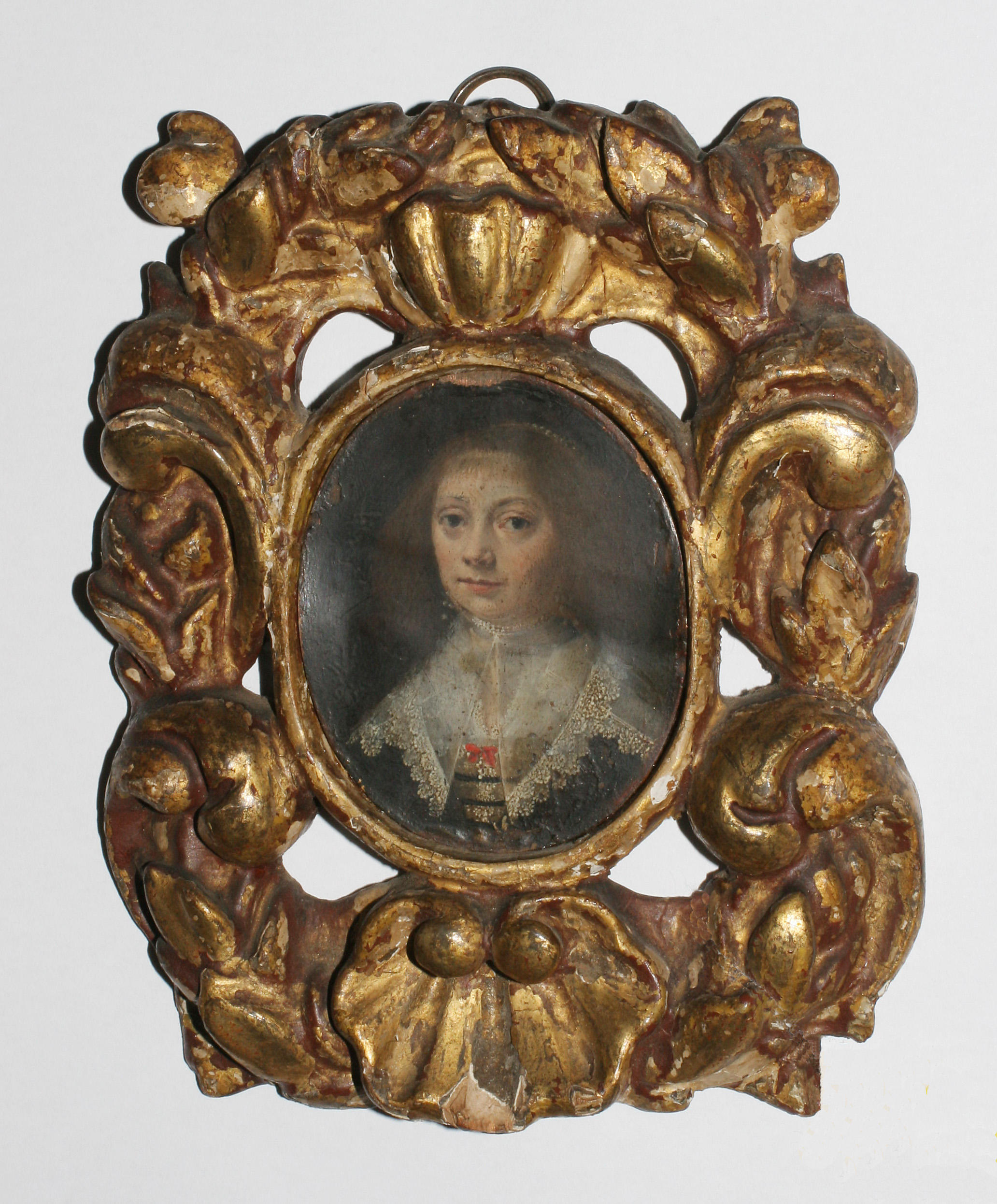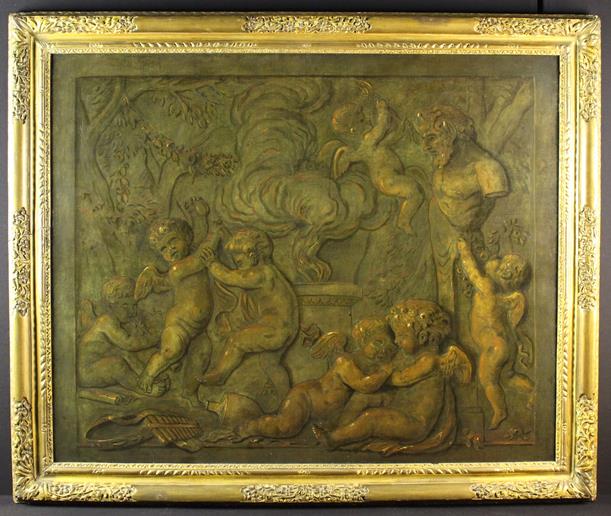Dutch Baroque Carved Giltwood and Gilt-Gesso Console Table in the Manner of Daniel Marot Late 17th century The marble serpentine top above a conforming stand with lambrequin and scroll-carved frieze centered by a pierced cabochon-, scroll- and shell-carved apron, raised on scrolled hipped legs headed by bearded soldiers with plumed helmets and joined by a shaped X-form stretcher and ending in carved bun feet; constructed in individual sections enabling disassembly. Height 34 inches (86.5 cm), width 6 feet 3 inches (190.5 cm), depth 33 1/2 inches (85 cm). Provenance: Sir Julius Wernher, 1st Baronet (1850-1912), Luton Hoo, Bedfordshire, by descent to his son. Major General Sir Harold Wernher, 3rd Baronet (1893-1973), Luton Hoo, Bedfordshire, and thence by descent. Sold, Christie's, London, Works of Art from Luton Hoo, Moyns Park and Munden, September 7, 1998, . The Parisian-trained architect and designer Daniel Marot (1661-1752), was one of the many Huguenots who went to either Holland or England to escape the religious persecution of protestants after the revocation of the Edict of Nantes by Louis XIV in 1685. Marot, who trained under his father, the architect and designer Jean Marot was also influenced by the French court designers Jean Lapautre and Jean Bérain Marot emigrated to Holland, where he entered the service of Prince William of Orange and it was at the Dutch court that he was able to introduce the opulent French style. Beginning in 1703, he published a series of designs, Oeuvres du Sr. D. Marot, architecte de Guillaume III, which he dedicated to his patron, now William III, 'King of Great Britain' that included designs from buildings to gardens, interiors, textiles, metalwork and furniture. The present table was conceived for use in a grand setting, indicating a commission of importance, as seen by its impressive proportions. The architectural aspect of this table is based on French prototypes, with plumed helmeted soldiers heading scrolled legs displaying its slightly earlier design origins. Similarly, the lambrequins and interlaced strapwork, found in Jean Bérain's oeuvre, were later adapted by Marot. An unusual constructional aspect exists on this table and is found on a group of very similar examples: it is easily able to be disassembled into fifteen separate pieces. A group of related tables is found in the Dutch royal collection, Het Loo Palace and the Rijksmuseum. C
Dutch Baroque Carved Giltwood and Gilt-Gesso Console Table in the Manner of Daniel Marot Late 17th century The marble serpentine top above a conforming stand with lambrequin and scroll-carved frieze centered by a pierced cabochon-, scroll- and shell-carved apron, raised on scrolled hipped legs headed by bearded soldiers with plumed helmets and joined by a shaped X-form stretcher and ending in carved bun feet; constructed in individual sections enabling disassembly. Height 34 inches (86.5 cm), width 6 feet 3 inches (190.5 cm), depth 33 1/2 inches (85 cm). Provenance: Sir Julius Wernher, 1st Baronet (1850-1912), Luton Hoo, Bedfordshire, by descent to his son. Major General Sir Harold Wernher, 3rd Baronet (1893-1973), Luton Hoo, Bedfordshire, and thence by descent. Sold, Christie's, London, Works of Art from Luton Hoo, Moyns Park and Munden, September 7, 1998, . The Parisian-trained architect and designer Daniel Marot (1661-1752), was one of the many Huguenots who went to either Holland or England to escape the religious persecution of protestants after the revocation of the Edict of Nantes by Louis XIV in 1685. Marot, who trained under his father, the architect and designer Jean Marot was also influenced by the French court designers Jean Lapautre and Jean Bérain Marot emigrated to Holland, where he entered the service of Prince William of Orange and it was at the Dutch court that he was able to introduce the opulent French style. Beginning in 1703, he published a series of designs, Oeuvres du Sr. D. Marot, architecte de Guillaume III, which he dedicated to his patron, now William III, 'King of Great Britain' that included designs from buildings to gardens, interiors, textiles, metalwork and furniture. The present table was conceived for use in a grand setting, indicating a commission of importance, as seen by its impressive proportions. The architectural aspect of this table is based on French prototypes, with plumed helmeted soldiers heading scrolled legs displaying its slightly earlier design origins. Similarly, the lambrequins and interlaced strapwork, found in Jean Bérain's oeuvre, were later adapted by Marot. An unusual constructional aspect exists on this table and is found on a group of very similar examples: it is easily able to be disassembled into fifteen separate pieces. A group of related tables is found in the Dutch royal collection, Het Loo Palace and the Rijksmuseum. C











Try LotSearch and its premium features for 7 days - without any costs!
Be notified automatically about new items in upcoming auctions.
Create an alert